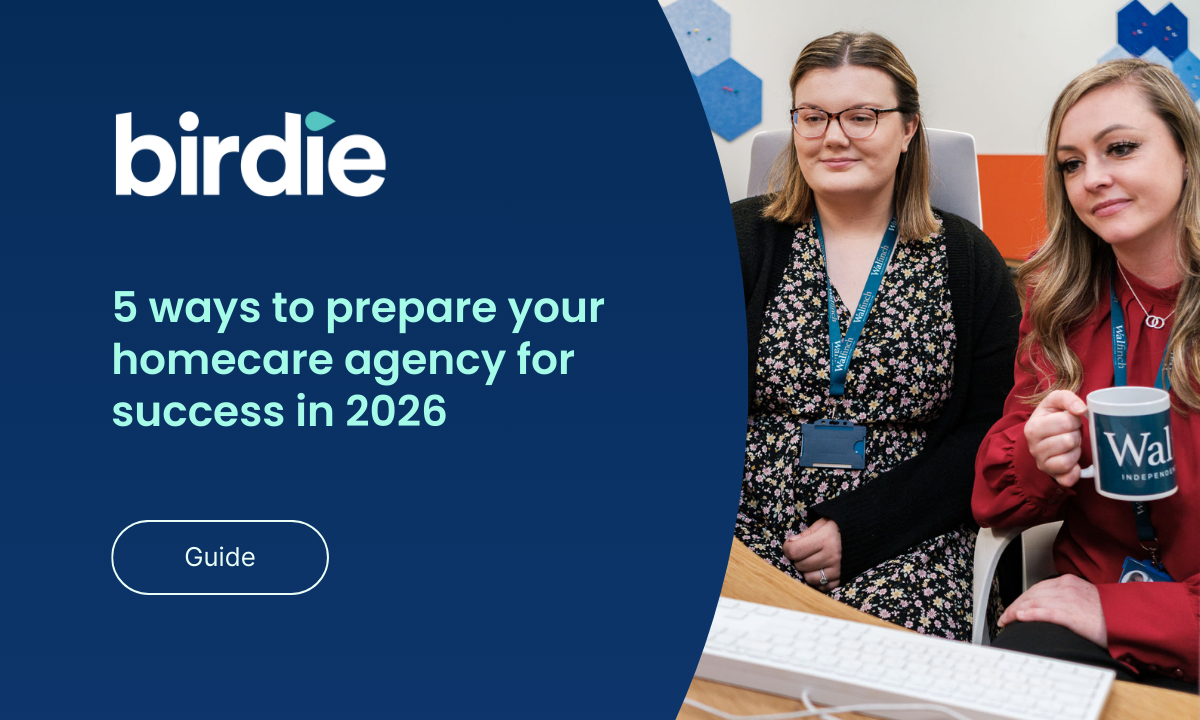Table of contents
As of April 2024, the CQC launched the single assessment framework across all health and social care providers. This framework has included a number of changes to the way the CQC perform inspections and provide a rating. Therefore the information below may contain some outdated information. For the latest information on what has changed and what you need to know, please head here.

What does it mean to provide quality care? CQC ratings and inspections are an essential tool in assessing the quality of care provided by domiciliary care agencies, but they’re few and far between - especially as the CQC resets itself following the pandemic.
So, how can you improve the quality of your care without waiting for an inspection?
Home care quality improvement tools like the Birdie Q Score can be a great place to start and help you assess your performance, so when your inspection rolls around there are no surprises, but there are some other fundamental things you should be doing to measure your quality performance too.
Whether you want to improve your rating or reach that milestone ‘outstanding’ score, there are several things you can do to show your inspector (and your staff and clients) that the care you provide is high quality.
Refer to the CQC rating framework
If you use a home care software solution (like Birdie) there are additional tools that you can use to assess the quality of your care (we’ll talk about a that in a moment), but the most important thing you should do is refer to the CQC rating framework. Why? Because this is what your home care agency will be judged on when it comes to your CQC inspection.
The CQC inspects home care agencies using a well-documented framework that follows their KLOEs (Key Lines of Enquiry). If you’ve already been inspected before, you should be familiar with the five KLOEs, but if you need a full refresh, you can read up on them, here.
You’ll be assessed based on the following five CQC standards:
- Safe: Are service users safe from abuse and harm?
- Effective: Is the care delivered effectively? Does it lead to good outcomes?
- Caring: Are staff caring and compassionate towards those in their care?
- Responsive: Are services responsive to the needs of service users?
- Well-led: Is the organisation well-led? Are there effective governance arrangements in place?
You should refer to the full documentation, here, as each KLOE has questions included that you’ll need to document and evidence. By reading up on the questions and understanding how ratings are assigned before your inspection, you can map your current business performance against the outcomes your inspector will expect.
Familiarise yourself with the CQC assessment methodology
The CQC has many published documents that outline how they will assess and regulate your business, but the first place you should look is their summary document: ‘How we regulate health and social care’.
This useful guide walks you through the process and includes information about appeals and complaints, in case you’re unhappy with the rating you receive.
Ok, now you’ve read up on what a CQC inspection entails you may be feeling a little overwhelmed, but don’t worry. A little known fact is that you only need two of the five KLOEs to be rated ‘outstanding’ to give your home care agency an overall outstanding rating.
If you’re feeling pretty confident about two of the KLOEs, here is where you should focus your efforts. Aim to get these to the highest level before your inspector calls to be on an excellent footing to reach outstanding.
Of course, that doesn’t mean you should neglect the others, but building on your strengths is a great place to start.
Evidence everything in one place
Working with paper files, MAR charts, comms sheets, body maps, and spreadsheets can be a difficult task to manage. And when it comes to your inspection, you could end up with a headache just trying to track everything down.
Evidence files kept in your office are a great way to keep everything together, but they can also be difficult to reference and comprehend if they haven’t been filed correctly.
Consider looking at home care software solutions, like Birdie to keep everything together and give you one handy point of reference that’ll help you document everything when it comes to your CQC inspection.
If you’re new to digital care planning and digital solutions for care delivery, take a look at our blog, below. It’ll walk you through five benefits that digital software solutions could have for your business, like:
- Offering more visibility
- Helping you to be more person-centred
- Reducing medication errors
- Sharing information quickly
- Giving you tools to become super responsive
Read: The 5 benefits of home care software
That’s not all.
When you need to show an inspector the actions you’ve taken (for example to remedy a situation or a medication error), you can quickly navigate to the client, date and time and show your inspector - in seconds.
Or, if you want to show your inspector how you’re person-centred, or how you measure risks, rather than flipping through pages and pages of paper care plans to find what you need, you can quickly search and find exactly what you’re looking for on Birdie.
For example, if you need to find out if there are any risks at a client’s home, you can visit your risk assessment on Birdie, find the relevant section and access the information instantly.
With everything in one place, CQC inspections and your monthly audits become a breeze.
Elite Care is one of our partner agencies. Recently awarded a CQC rating of outstanding in responsiveness, Emma told us how Birdie is helping to revolutionise care delivery at Elite Care.
Before Birdie, the agency was auditing infrequently, which meant that it was tough for them to keep track of changes or problems. Now, with Birdie, they audit almost automatically, every day, which means that when it comes to being responsive, they scored an Outstanding rating with the CQC.
Stay on top of your performance
We know it’s challenging to stay on top of things. And suggesting you track your performance daily probably sounds like a stretch right now. But, with the right quality improvement tools in place, it’s straightforward.
At Birdie, we developed the Q Score (short for Quality Score) to help you do just that. The Q Score is a weekly report that aligns with the CQC KLOEs and gives you a weekly insight into your performance, based on things like visit length, visits on time, overruns and underruns, responsiveness and person-centred actions taken by you and your staff.
In a nutshell, your Quality Score is an overall score form 1-4. The higher your score, the better your agency is doing. Just like your CQC rating, your score aligns to how you’re doing. A score of 1 would indicate that you’re doing ‘inadequately’, 2 would correspond to ‘needing improvement’, 3 is ‘good’ and 4, ‘outstanding’.
Your Quality Score takes into account four key areas and looks at how you’re currently performing in each. Each area aligns to a KLOE, which means that you can see where you need to improve your CQC rating.
We use the following areas to calculate your score:
Care Delivery
Care Planning
Responsiveness
Caring Staff
To get a full understanding of how the Q Score works, you can read about it here - or read an interview with Alina Homecare who have been using Q Score to improve their CQC rating across multiple branches, here.

Gather feedback from your clients and their families
When a CQC inspector audits a care home, they’ll usually ask the residents for their feedback and opinions on the level of care they receive.
For domiciliary care, this can be far more difficult. To show that your business is truly responsive and well-led, it’s a good idea to establish regular surveys to your clients and their loved ones - to see how you’re performing.
Asking for feedback can seem like opening a can of worms. With so many people involved in a single person’s care, there will be many opinions that need to be respected. But, it can be a useful listening tool and one that will help with your CQC rating.
It’s important to note that if you receive feedback that highlights improvements or requests, be sure to communicate what you’ll do to action it - to both your staff and your clients and their families.
The easiest way to gather feedback is through a survey, which you can create quickly online and send easily via email. Typeform and Google Forms are great tools for this.
You should also be in regular contact with the people you care for, to offer them the opportunity to direct and discuss their care. Find out what’s working for them, what they’d like more of and how you can support it. This helps to maintain a person-centred approach and ensures they are always in control of their care. And, when it comes to your CQC inspection, your inspector will be able to see the actions you’ve taken to ensure that everyone stays fully involved in all aspects of their care.
If you’d like to know how Birdie could help with your CQC inspections, get in touch with us or book a demo.
Published date:
September 4, 2020
Author:
Emma-Lee Curtis

.png)
















.svg)